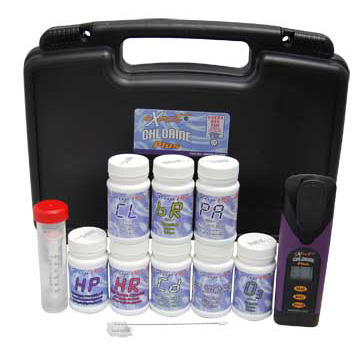One of the most widely used testing methods for free and total chlorine makes use of something known as ‘DPD’ which stands for N,N Diethyl-1,4 Phenylenediamine Sulfate. The addition of DPD to water samples containing oxidizers such as free chlorine, bromine, iodine, chlorine dioxide and/or permanganate results in the formation of a reddish tint to the water whose intensity directly relates to the amount of oxidizer(s) present in the water sample.
At low oxidizer concentrations water samples turn a slight shade of pink in the presence of DPD and at higher oxidizer concentrations the sample will turn blood-red orange. In extremely high concentrations of oxidizers, as in above 10 ppm, the sample will turn blood-red and then go crystal clear due to the bleaching effect of the oxidizer(s) it contains.
Other oxidizers such as ozone and total chlorine do not react directly with DPD and require the addition of a compound known as Potassium Iodide (KI) before they will react with DPD.
- DPD-1 — Used to test oxidizer levels in water samples containing free chlorine, bromine, iodine, chlorine dioxide and/or permanganate.
- DPD-3 — Useless on its own, but when added to samples already containing DPD-1 and free chlorine, total chlorine, bromine, iodine, chlorine dioxide, permanganate and/or ozone, pink through blood-red color development will occur in the sample.
- DPD-4 — The combination of DPD-1 (N,N Diethyl-1,4 Phenylenediamine Sulfate) and DPD-3 (KI) to samples containing free chlorine, total chlorine, bromine, iodine, chlorine dioxide, permanganate and/or ozone will result in pink through blood-red color development in the sample. Simply put, DPD-1 + DPD-3 = DPD-4.
DPD comes in various forms, the most common of which include tablets, powder pillows, liquids and ReagentStripsTM. Each works equally well when used correctly and may typically be interchanged with one another, though all do have their pros and cons.
- Tablets: One of the cheapest forms of DPD available and has a very long shelf-life. Difficult to break apart and dissolve in cold or hard water samples and may leave suspended solids floating around in samples.
- Powder Pillows: Inexpensive form of DPD. Difficult to dissolve in cold or hard water samples and may leave suspended solids floating around in samples. Users also complain of ‘annoyance value’ associated with having to tear the foil pillows open and pour the DPD powder into the sample vials. Not well-suited for outdoor testing.
- Liquids: Shorter shelf-life and much more unstable than other forms of DPD, considered ‘messy’ by many users, but also probably the expensive form of DPD.
- ReagentStripsTM: Convenient delivery method for DPD, rarely leaves undissolved solids in samples regardless of temperature or hardness, decent shelf-life, and available in bottles of 50 or individually wrapped tests (excellent for field work).
While many test protocols call only for a visual verification of chlorine levels in water determined through the use of DPD testing methods, many others require the use of a digital chlorine analyzer and DPD testing methods. Below please find an EPA Compliant meter which make use of DPD chemistry for chlorine concentration determination:
- eXact Micro 7+ Water Quality Testing Meter — EPA Compliant for free and total chlorine when used in conjunction with a DPD-based reagent system. Handheld multi-parameter water quality testing meter. IP67 waterproof rating and the unit floats. Made from recyclable parts and uses 60% less reagent than devices using 10 mL samples.
Update — Got a chlorine test kit/meter that has a 10 mL sample size and uses DPD-1 tablets, powders or liquids? If so, then you definitely want to check out DPD-1 ReagentStrips for free chlorine. They mix into solution much quicker, easier and cleanly than DPD powders and DPD tablets and have a much longer shelf life than DPD liquids.
The USEPA has accepted DPD-1 ReagentStrips for reporting water and wastewater analysis. That means the USEPA has found the DPD-1 ReagentStrip free chlorine testing procedure equivalent to its own USEPA method 330.5 for wastewater and Standard Method 4500-Cl G for drinking water when used with Palintest Chlorometer 1000 or equivalent.
Update — Want to use less water when testing for free (and total) chlorine? The eXact Chlorine Photometer requires 60% less test sample and meets the criteria for a USEPA Compliant Meter for free and total chlorine testing.







